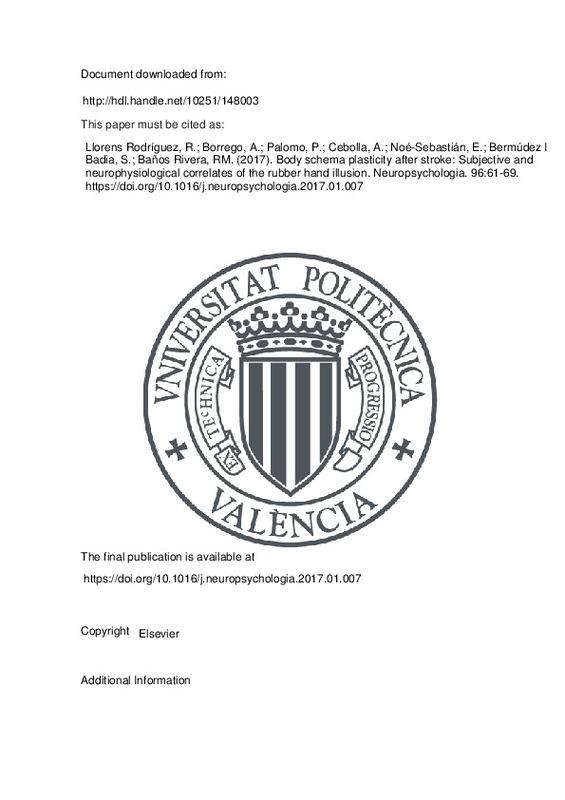JavaScript is disabled for your browser. Some features of this site may not work without it.
Buscar en RiuNet
Listar
Mi cuenta
Estadísticas
Ayuda RiuNet
Admin. UPV
Body schema plasticity after stroke: Subjective and neurophysiological correlates of the rubber hand illusion
Mostrar el registro sencillo del ítem
Ficheros en el ítem
| dc.contributor.author | Llorens Rodríguez, Roberto
|
es_ES |
| dc.contributor.author | Borrego, Adrián
|
es_ES |
| dc.contributor.author | Palomo, Priscila
|
es_ES |
| dc.contributor.author | Cebolla, Ausiàs
|
es_ES |
| dc.contributor.author | Noé-Sebastián, Enrique
|
es_ES |
| dc.contributor.author | Bermúdez i Badia, Sergi
|
es_ES |
| dc.contributor.author | Baños Rivera, Rosa María
|
es_ES |
| dc.date.accessioned | 2020-07-15T03:32:19Z | |
| dc.date.available | 2020-07-15T03:32:19Z | |
| dc.date.issued | 2017-02 | es_ES |
| dc.identifier.issn | 0028-3932 | es_ES |
| dc.identifier.uri | http://hdl.handle.net/10251/148003 | |
| dc.description.abstract | [EN] Stroke can lead to motor impairments that can affect the body structure and restraint mobility. We hypothesize that brain lesions and their motor sequelae can distort the body schema, a sensorimotor map of body parts and elements in the peripersonal space through which human beings embody the reachable space and ready the body for forthcoming movements. Two main constructs have been identified in the embodiment mechanism: body-ownership, the sense that the body that one inhabits is his/her own, and agency, the sense that one can move and control his/her body. To test this, the present study simultaneously investigated different embodiment subcomponents (body-ownership, localization, and agency) and different neurophysiological measures (galvanic skin response, skin temperature, and surface electromyographic activity), and the interaction between them, in clinically-controlled hemiparetic individuals with stroke and in healthy subjects after the rubber hand illusion. Individuals with stroke reported significantly stronger body-ownership and agency and reduced increase of galvanic skin response, skin temperature, and muscular activity in the stimulated hand. We suggest that differences in embodiment could have been motivated by increased plasticity of the body schema and pathological predominance of the visual input over proprioception. We also suggest that differences in neurophysiological responses could have been promoted by a suppression of the reflex activity of the sympathetic nervous system and by the involvement of the premotor cortex in the reconfiguration of the body schema. These results could evidence a body schema plasticity promoted by the brain lesion and a main role of the premotor cortex in this mechanism. | es_ES |
| dc.description.sponsorship | This work was supported by Ministerio de Economia y Competitividad of Spain (Project NeuroVR, TIN2013-44741-R, Project REACT, TIN2014-61975-EXP, and Grant BES-2014-068218), and by Universitat Politecnica de Valencia (Grant PAID-10-14). | es_ES |
| dc.language | Inglés | es_ES |
| dc.publisher | Elsevier | es_ES |
| dc.relation.ispartof | Neuropsychologia | es_ES |
| dc.rights | Reserva de todos los derechos | es_ES |
| dc.subject | Body schema | es_ES |
| dc.subject | Body-ownership | es_ES |
| dc.subject | Embodiment | es_ES |
| dc.subject | Rubber hand illusion | es_ES |
| dc.subject | Stroke | es_ES |
| dc.subject | Neurophysiology | es_ES |
| dc.subject.classification | INGENIERIA TELEMATICA | es_ES |
| dc.subject.classification | TEORIA DE LA SEÑAL Y COMUNICACIONES | es_ES |
| dc.title | Body schema plasticity after stroke: Subjective and neurophysiological correlates of the rubber hand illusion | es_ES |
| dc.type | Artículo | es_ES |
| dc.identifier.doi | 10.1016/j.neuropsychologia.2017.01.007 | es_ES |
| dc.relation.projectID | info:eu-repo/grantAgreement/UPV//PAID-10-14/ | es_ES |
| dc.relation.projectID | info:eu-repo/grantAgreement/MINECO//TIN2013-44741-R/ES/REALIDAD VIRTUAL PARA LA COMPRENSION Y LA PROMOCION DE LOS MECANISMOS NEURALES DE INTERACCION Y REHABILITACION/ | es_ES |
| dc.relation.projectID | info:eu-repo/grantAgreement/MINECO//TIN2014-61975-EXP/ES/REHABILITACION DE ESTADOS ALTERADOS DE CONCIENCIA EN FASE TEMPRANA/ | es_ES |
| dc.relation.projectID | info:eu-repo/grantAgreement/MINECO//BES-2014-068218/ES/BES-2014-068218/ | es_ES |
| dc.rights.accessRights | Abierto | es_ES |
| dc.contributor.affiliation | Universitat Politècnica de València. Instituto Interuniversitario de Investigación en Bioingeniería y Tecnología Orientada al Ser Humano - Institut Interuniversitari d'Investigació en Bioenginyeria i Tecnologia Orientada a l'Ésser Humà | es_ES |
| dc.description.bibliographicCitation | Llorens Rodríguez, R.; Borrego, A.; Palomo, P.; Cebolla, A.; Noé-Sebastián, E.; Bermúdez I Badia, S.; Baños Rivera, RM. (2017). Body schema plasticity after stroke: Subjective and neurophysiological correlates of the rubber hand illusion. Neuropsychologia. 96:61-69. https://doi.org/10.1016/j.neuropsychologia.2017.01.007 | es_ES |
| dc.description.accrualMethod | S | es_ES |
| dc.relation.publisherversion | https://doi.org/10.1016/j.neuropsychologia.2017.01.007 | es_ES |
| dc.description.upvformatpinicio | 61 | es_ES |
| dc.description.upvformatpfin | 69 | es_ES |
| dc.type.version | info:eu-repo/semantics/publishedVersion | es_ES |
| dc.description.volume | 96 | es_ES |
| dc.identifier.pmid | 28077329 | es_ES |
| dc.relation.pasarela | S\324006 | es_ES |
| dc.contributor.funder | Universitat Politècnica de València | es_ES |
| dc.contributor.funder | Ministerio de Economía y Competitividad | es_ES |







![[Cerrado]](/themes/UPV/images/candado.png)

